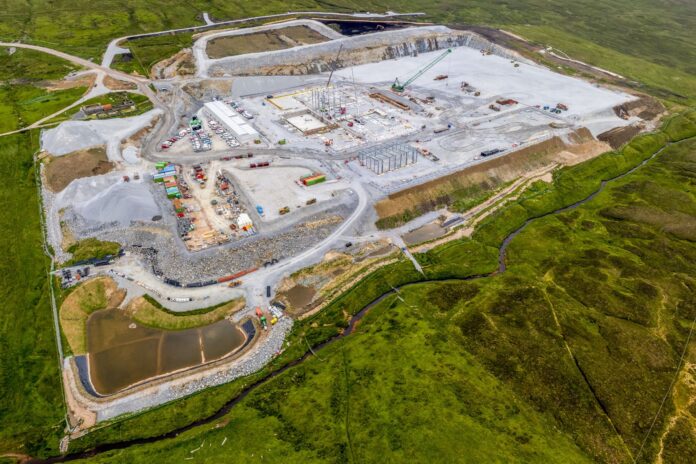UK-based civil engineering company BAM Nuttal has switched on a private 5G network to provide connectivity for construction services at a 55,00 square-metre site in the Shetland Islands in the UK, where it has been contracted by Scottish and Southern Electricity Networks (SSEN) as part of the UK government’s £642 million project to build a sub-sea transmission link to the UK mainland.
It is the first use of a private standalone 5G network on a construction site in the UK, said BAM Nuttal. The 5G network, in trial mode, is part of the UK government’s country-wide 5G testbeds campaign, funded by its Department for Digital, Culture, Media & Sport (DCMS), with major centres also in the West Midlands and the Southwest of the country.
UK-based startup Attocore is providing the 5G core network; the RAN provider has not been confirmed, but is understood to be another UK-based startup, in line with the government mission to champion the local telco supply chain. The Building Research Establishment (BRE), a former UK government national laboratory, now owned by the BRE Trust, is also involved as part of a consortium effort on the private 5G setup.
Somewhat convoluted, but in accordance with the government’s co-creation around Industry 4.0 funding and deployments, the new consortium providing the new networking elements in the SSEN transmission project is also partnering with the 5PRING accelerator programme, which includes Telefónica and Deloitte in the West Midlands 5G (WM5G) initiative, working with start-ups to improve manufacturing technology in the construction sector.
The Shetland project will “test the potential of new digital technology and demonstrate tangible benefits, along with other stand-alone networks implemented across a range of industries”, said BAM Nuttall. The new sub-sea high voltage direct current (HVDC) power line is to connect Kergord in Shetland and Caithness in Scotland; it will use around 260 kilometres of cabling, and see construction of a substation and convertor station on the Shetland side.
It will bring the Shetland Isles, the northerly most point in the UK, into the UK energy system for the first time, and also connect renewable electricity generation from the new Viking wind farm, currently being built by SSEN-parent SSE Renewables on the Shetland mainland. The project is designed to reduce Shetland’s dependence on thermal power, and secure its ‘energy future’.
For the UK, the new sub-sea HVDC link will go alongside the existing Caithness-Moray line to create Europe’s first multi-terminal HVDC system and the world’s first outside of China. “The two HVDC links represent the most significant investment ever in the electricity transmission network in the north of Scotland,” says the UK government. The Shetland link is due to go live in 2024.
BAM Nuttal is designing and constructing the civil infrastructure on a 55,176 square-metre site at Kergord (described as “challenging terrain… cold, wet, and harsh”) for the new substation and convertor station on the Shetland side of the HVDC link. It said: “The project… provides the ideal conditions to measure the benefits for the construction industry. Challenges typically faced on building sites are magnified and will stretch the use of 5G technology.”
It added: “Clients and management teams can’t easily visit the site and rely on reports, data, images and insights to track progress and make decisions, based in offices, hundreds of miles from site. BAM’s project team is collecting evidence of how new technology can help improve safety, sustainability and increase collaboration. They’ll create more effective and efficient solutions to fix age-old challenges for wider adoption across the construction industry.”
The team said it will look to deploy cameras and drones, augmented and virtual reality (AR and VR), and AI and IoT. Benefits, it said, would include safety (“AI to carry out site surveys and send back live data”), quality assurance (“more data analytics… [plus] AR and digital models… [and] more collaboration”), and “live” decision making (with “drone footage and cameras on site”).
A part of the focus is also to show that 5G can help with “flexible working” and “increase the appeal of careers in construction to a wider diversity of people”.
It said: “5G has rarely been used by the construction industry, and this first fully functioning network allows BAM to explore how far we can go to change the way we work; using a mix of digital tools to cover the full extent of the Shetland site, while our people control the technology and use their time to analyse data gathered to improve decision-making and our delivery methods.”
Colin Evison, head of innovation at BAM Nuttall, said: “5G is unlocking increased use of digital tools and models as we explore safer, more modern and efficient ways to work in construction. We’re excited for the next steps as we trial new solutions which, without the 5G network, wouldn’t be possible.”
Julia Lopez, the UK government minister for media, data and digital infrastructure, said: “5G can revolutionise the way Britain builds, which is why we’re investing £200 million in cutting-edge innovation projects to ensure we unleash its ability to drive growth across the construction industry. With 5G now switched on at this exciting project in Shetland, it will unlock a huge range of transformative tech.”

